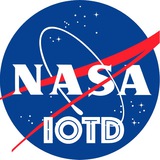July 26 is National Intern Day. See how far these two former interns at NASA's Jet Propulsion Laboratory have come! http://www.nasa.gov/sites/default/files/thumbnails/image/jsc2017e111693.jpg
Saturn is the solar system’s most photogenic planet, especially in this latest Hubble snapshot with the ring system near its maximum tilt. http://www.nasa.gov/sites/default/files/thumbnails/image/stsci-h-p1829b-m-2000x1230.png
The International Space Station soars into a sunrise every 90 minutes, each and every day. http://www.nasa.gov/sites/default/files/thumbnails/image/43656168861_3c30e55b14_o.jpg
NASA’s Parker Solar Probe has cleared the final procedures in the clean room before its move to the launch pad. http://www.nasa.gov/sites/default/files/thumbnails/image/fencap2.jpg
More than a dozen wildfires are burning in the state of California, with several of them threatening life and property http://www.nasa.gov/sites/default/files/thumbnails/image/califire.jpg
Administration Jim Bridenstine tours the inside of the Orion test crew capsule, Thursday, Aug. 2, 2018 at NASA's Johnson Space Center in Houston, Texas. http://www.nasa.gov/sites/default/files/thumbnails/image/43088894214_b3f687c43b_k.jpg
The first U.S. astronauts who will fly on American-made commercial spacecraft, to and from the International Space Station, wave after being announced, Friday, Aug. 3, 2018. http://www.nasa.gov/sites/default/files/thumbnails/image/43778247512_598b3a1e5e_o.jpg
The Earth, in all its majesty and its tragedy, is the subject of images taken aboard the International Space Station. This image of the Carr and Ferguson fires was captured from the station on August 3, 2018, by European Space Agency astronaut Alexander Gerst. http://www.nasa.gov/sites/default/files/thumbnails/image/iss056e102551.jpg
The Columbia Glacier descends from an ice field 10,000 feet and into a narrow inlet that leads into Prince William Sound in southeastern Alaska. http://www.nasa.gov/sites/default/files/thumbnails/image/columbia_tm5_1986209_lrg.jpg
Who was Mary Ross? Another 'hidden figure,' a mathematician and engineer. http://www.nasa.gov/sites/default/files/thumbnails/image/ross.jpg
Inside the United Launch Alliance Delta IV Heavy rocket payload fairing on Wednesday, August 8, 2018, the Parker Solar is slated to launch at 3:33 a.m. EDT, Saturday, August 11. http://www.nasa.gov/sites/default/files/thumbnails/image/43218692434_ef80b61985_k.jpg
A United Launch Alliance Delta IV Heavy rocket launches NASA's Parker Solar Probe on a mission to touch the Sun, on Sunday, Aug. 12, 2018 from Launch Complex 37 at Cape Canaveral Air Force Station, Florida. http://www.nasa.gov/sites/default/files/thumbnails/image/42184535980_f738b67cb6_o.jpg
The largest fire in California's history, the Mendocino Complex, is still spewing clouds of smoke across the state. http://www.nasa.gov/sites/default/files/thumbnails/image/california-fires-081218.jpg
Ever wondered what auroras look like from space? http://www.nasa.gov/sites/default/files/thumbnails/image/42151120000_84f4bdc18a_k.jpg
NASA's Solar Dynamics Observatory (SDO) scientists used their computer models to generate a view of the Sun's magnetic field on August 10, 2018. The bright active region right at the central area of the Sun clearly shows a concentration of field lines, as well as the small active region at the Sun's right edge. http://www.nasa.gov/sites/default/files/thumbnails/image/pia22662.jpeg
Wishing legendary NASA flight director Gene Kranz the happiest of birthdays! http://www.nasa.gov/sites/default/files/thumbnails/image/s26-s-113_large.jpg
Our cloud-covered planet is seen from aboard the International Space Station. http://www.nasa.gov/sites/default/files/thumbnails/image/43367342334_1159c4f1f6_k.jpg
One year ago on August 21, 2017, the continental United States experienced the first total solar eclipse in 99 years. http://www.nasa.gov/sites/default/files/thumbnails/image/jsc2017e110803_0.jpg
The world is on fire. Or so it appears in this image from NASA's Worldview. http://www.nasa.gov/sites/default/files/thumbnails/image/worldfires-08232018.jpg
Even if the air looks clear, it is nearly certain that you will inhale millions of solid particles and liquid droplets. These ubiquitous specks of matter are known as aerosols, and they can be found in the air over oceans, deserts, mountains, forests, ice and every ecosystem in between. http://www.nasa.gov/sites/default/files/thumbnails/image/atmosphere_geo5_2018235_eq.jpg
